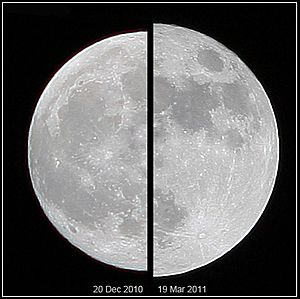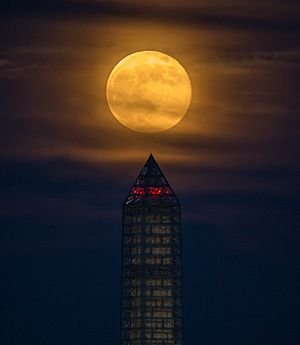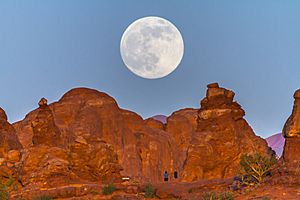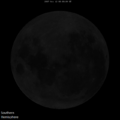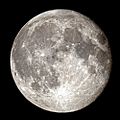Supermoon facts for kids
A supermoon happens when the Moon is full or new and is also very close to Earth. Because it's closer, the Moon looks a bit bigger and brighter than usual in the sky. The word "supermoon" comes from astrology, which is about how stars and planets might affect people.
When the Moon is farthest away, it's called a micromoon.
Contents
When Do Supermoons Happen?
Each year, there are usually 12 or 13 full moons. Out of these, about 3 or 4 are "supermoons."
The most recent full supermoon happened on August 31, 2023. The next one will be on September 29, 2023. The biggest supermoon of the century is expected on December 6, 2052. On that day, the Earth and Moon will be extremely close!
Sometimes, a supermoon happens at the same time as a total lunar eclipse. This means the Moon looks super big and also turns a reddish color during the eclipse. This last happened in May 2022. The next time we'll see this amazing event is in October 2032.
How a Supermoon Looks
When the Moon is at its closest point to Earth (called perigee), it looks about 14% larger than when it's farthest away (called apogee). Many people think the Moon looks even bigger, especially when it's low in the sky after sunset. This is often due to something called the moon illusion, which makes the Moon seem huge when it's near the horizon.
Even though the Moon's surface brightness stays the same, it appears about 30% brighter during a supermoon. This is because it's closer to us, so more light reaches our eyes.
What Does "Supermoon" Mean?
The name supermoon was first used by an astrologer named Richard Nolle in 1979.
In the world of science, experts prefer to use the term perigee-syzygy or perigee full/new moon.
- Perigee is the point in the Moon's path where it is closest to Earth.
- Syzygy is when the Earth, Moon, and Sun all line up. This alignment happens every time there's a full moon or a new moon.
Supermoon's Effect on Earth
Scientists know that the pull of the Sun and Moon together affects the Earth's oceans, causing tides. This pull is strongest when the Moon is new or full.
However, even when the Moon is at its closest point during a supermoon, this extra pull is still quite small. It only causes the tides to be a few inches higher or lower than usual. So, supermoons don't cause huge floods or other big changes on Earth.
Images for kids
-
Animation of the Moon as it cycles through its phases, as seen from the southern hemisphere.
See also
 In Spanish: Superluna para niños
In Spanish: Superluna para niños


